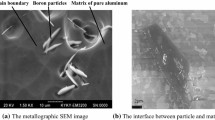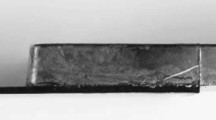Abstract
Steel aluminum composite materials are widely used in engineering owing to excellent weight efficiency in combination with good mechanical properties. They are used, for instance, in the aerospace industry for production of rocket body structures, fuel tanks, and aircraft armor elements. This work is devoted to analysis of the crack resistance and the mechanism of destruction of aluminum-steel (20 vol %) composite material with the density of 2.85 g/cm3. The composite material was produced using very fine PAP-2 aluminum powder for formation of its matrix component. The reinforcing component was made of steel mesh woven from austenitic steel rope (08Kh17N13M2). The strength of the produced material upon transverse bending (550–600 MPa) was calculated by the maximum load corresponding to the first step of crack originating in the matrix. Its crack resistance at the stage of fracture initiation estimated by the parameter K1c was from 15 to 30 MPa m1/2. The crack resistance of the composite material at the stage of development of fracture was described by means of specific effective fracture work YF = 2 × 104—8 × 104 J/m2. For this composite material YF is an order of magnitude higher than for St3 steel, D16T aluminum alloy, and VT-5 titanium alloy, which is an advantage of the developed material. The high value of parameter YF is attributed to the mechanism of energy intensive destruction. It is provided by the increased energy consumption for the destruction of the bridges between the matrix aluminum layers by their shearing by the rope as a result of the action of shear stresses, for overriding of friction forces of rope drawing from the matrix, and for shearing of laminated packets inside the matrix formed by diffusion bonded scaly particles. The properties of the produced steel-aluminum composite material allow its use as a material for light structural elements operated under conditions of mechanical loading.







Similar content being viewed by others
REFERENCES
Ivanov, D.A., Sitnikov, A.I., and Shlyapin, S.D., Kompozitsionnye materialy (Composite Materials), Moscow: Yurait, 2019.
Trykov, Yu.P., Gurevich, L.M., and Shmorgun, V.G., Sloistye kompozity na osnove alyuminiya i ego splavov (Layered Composites Based on Aluminum and Its Alloys), Moscow: Metallurgizdat, 2004.
Mileiko, S.T., Micro- and macrocracks in composites, Mekh. Kompozit. Mater., 1979, no. 2, pp. 276–279.
Anishchenkov, V.M. and Mileiko, S.T., Fatigue failure of a layered composite, Dokl. Akad. Nauk SSSR, 1978, vol. 241, no. 5, pp. 1068–1069.
Fridlyander, I.N., Modern aluminum and magnesium alloys and composite materials based on them, Met. Sci. Heat Treat., 2002, vol. 44, no. 7, pp. 292–296.
Materialovedenie i tekhnologiya materialov (Material Science and Technology of Materials), Fetisov, G.P., Ed., Moscow: Yurait, 2018, part 1.
Kompozitsionnye materialy: razrabotka, dinamicheskie ispytaniya, matematicheskoe modelirovanie (Composite Materials: Development, Dynamic Testing, and Mathematical Modeling), Ishchenko, A.N., Ed., Tomsk: Izd. Nauchno-Tekh. Lit., 2016.
Kuzmich, Yu.V., Kolesnikova, I.G., Serba, V.I., and Freidin, B.M., Mekhanicheskoe legirovanie (Mechanical Alloying), Apatity: Kol’sk. Nauchn. Tsentr, Ross. Akad. Nauk, 2004.
Dinesh, K., Geeta, A., and Rajesh, P., Properties and characterization of Al–Al2O3 composites processed by casting and powder metallurgy routes (review), Int. J. Latest Trends Eng. Technol., 2013, vol. 2, no. 4, pp. 486–496.
Kang, Y.-C. and Chan Sammy, L.-I., Tensile properties of nanometric Al2O3 particulate–reinforced aluminum matrix composites, Mater. Chem. Phys., 2004, vol. 85, pp. 438–443.
Razavi Hesabi, Z., Simch, A., and Seyed Reihani, S.M., Structural evolution during mechanical milling of nanometric and micrometric Al2O3 reinforced Al matrix composites, Mater. Sci. Eng., A, 2006, vol. 428, pp. 159–168.
Razavi Hesabi, Z., Hafizpour, H.R., and Simchi, A., An investigation on the compressibility of aluminum/nano-alumina composite powder prepared by blending and mechanical milling, Mater. Sci. Eng., A, 2007, vols. 449–451, pp. 829–832.
Tavoosi, M., Karimzadeh, F., Enayati, M.H., and Heidarpour, A., Al–Zn/Al2O3 nanocomposite prepared by reactive milling and hot pressing methods, J. Alloys Compd., 2009, vol. 475, pp. 198–201.
Poirier, D., Drew, R.A.L., Trudeau, M.L., and Gauvin, R., Fabrication and properties of mechanically milled alumina/aluminum nanocomposites, Mater. Sci. Eng., A, 2010, vol. 527, pp. 7605–7614.
Tabandeh, Kh.M., Jenabali, J.S.A., and Moshksar, M.M., Mechanical properties of tri-modal Al matrix composites reinforced by nano- and submicron-sized Al2O3 particulates developed by wet attrition milling and hot extrusion, Mater. Des., 2010, vol. 454, pp. 1–16.
Razavi-Tousi, S.S., Yazdani-Rad, R., and Manafi, S.A., Effect of volume fraction and particle size of alumina reinforcement on compaction and densification behavior of Al–Al2O3 nanocomposites, Mater. Sci. Eng., A, 2011, vol. 528, pp. 1105–1110.
Ivanov, D.A., Ivanov, A.V., and Shlyapin, S.D., Investigation into physicomechanical properties and structure of the Al–Al2O3 composite material fabricated using mechanical treatment of the PAP-2 aluminum powder and reaction sintering of powder billets, Russ. J. Non-Ferrous Met., 2016, vol. 57, no. 2, pp. 148–156.
Ivanov, D.A., Shlyapin, S.D., Valiano, G.E., Akkuzhin, N.D., and Fedorova, L.V., Studying the influence of vacuum heat treatment of PAP-2 powder on its compressibility and properties of sintered material, Tekhnol. Legk. Splavov, 2017, no. 3, pp. 68–74.
Barinov, S.M. and Shevchenko, V.Ya., Prochnost’ tekhnicheskoi keramiki (The Strength of Technical Ceramics), Moscow: Nauka, 1996.
Abramov, A.A. and Tikhomirov, M.D., The technology for producing high-quality castings from high-strength cast aluminum alloys, Liteinoe Proizvod., 2007, no. 5, pp. 29–34.
Illarionov, A.G. and Popov, A.A., Tekhnologiya i ekspluatatsionnye svoistva titanovykh splavov (Technology and Performance Properties of Titanium Alloys), Yekaterinburg: Ural. Gos. Univ., 2014.
Rakhimkulov, R.R., Comparison of the values of fracture toughness K 1c obtained on samples with chevron cutting and according to the standard procedure for steel St3sp, Neftegaz. Delo, 2010, no. 2, pp. 59–69.
Shevchenko, V.Ya. and Barinov, S.M., Tekhnicheskaya keramika (Technical Ceramics), Moscow: Nauka, 1993.
Funding
This work was supported by state contract no. 11.7568.2017/B4 using the core facilities Aerospace Materials and Technologies, Moscow Aviation Institute.
Microscopic analysis was performed at the Joint Institute for High Temperatures, Russian Academy of Sciences, in accordance with the state contract of the Russian Academy of Sciences for basic research, project GR no. АААА-А-16-116051810082-7.
Author information
Authors and Affiliations
Corresponding author
Additional information
Translated by I. Moshkin
Rights and permissions
About this article
Cite this article
Ivanov, D.A., Shlyapin, S.D., Valiano, G.E. et al. Studying Crack Resistance and Destruction Mechanism of Steel Aluminum Composite Material. Inorg Mater 57, 1535–1540 (2021). https://doi.org/10.1134/S0020168521150097
Received:
Revised:
Accepted:
Published:
Issue Date:
DOI: https://doi.org/10.1134/S0020168521150097




